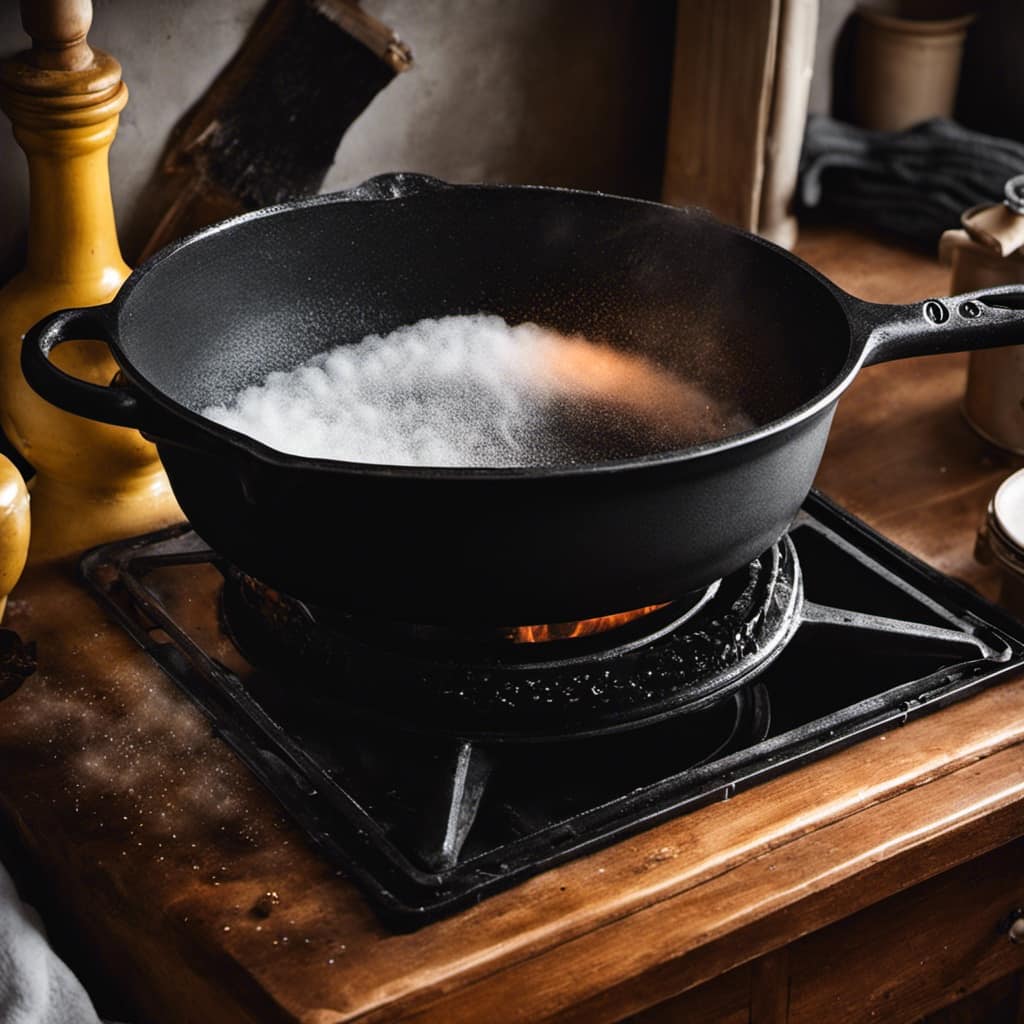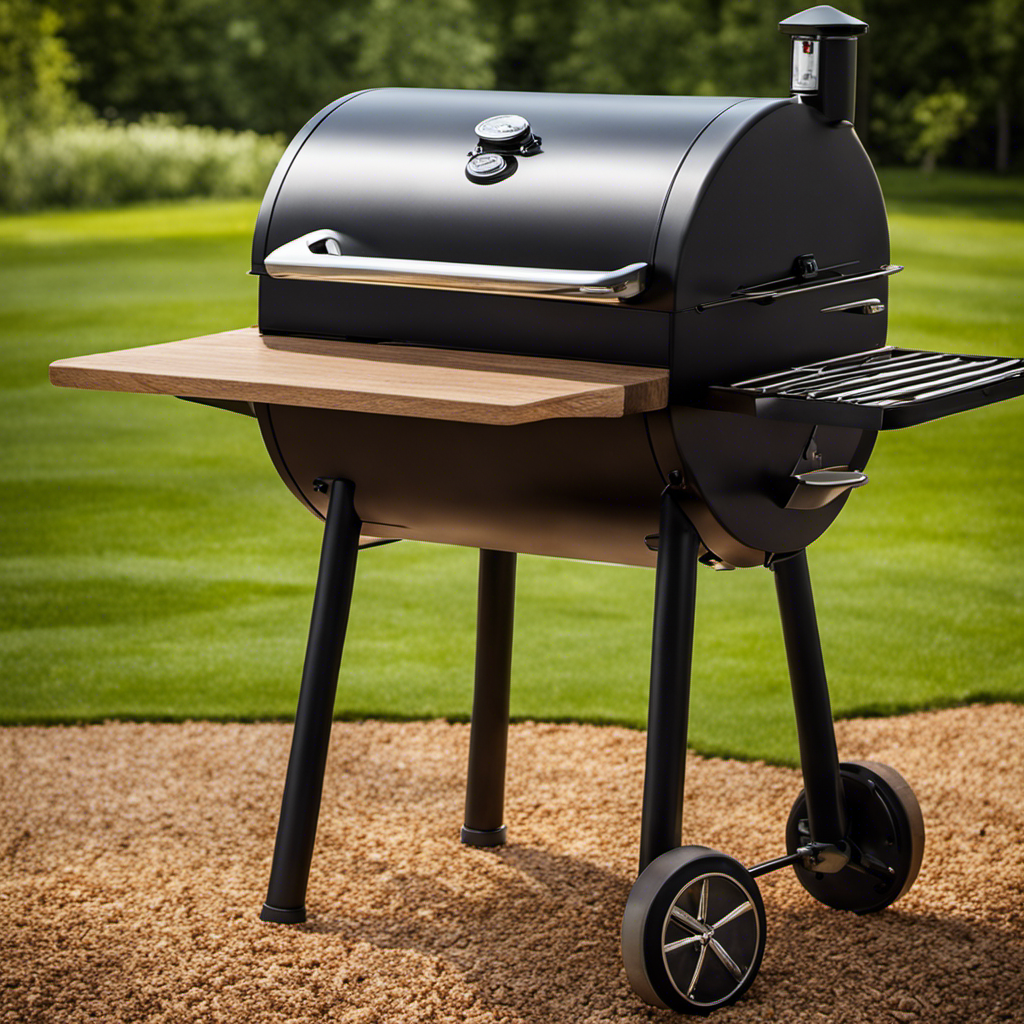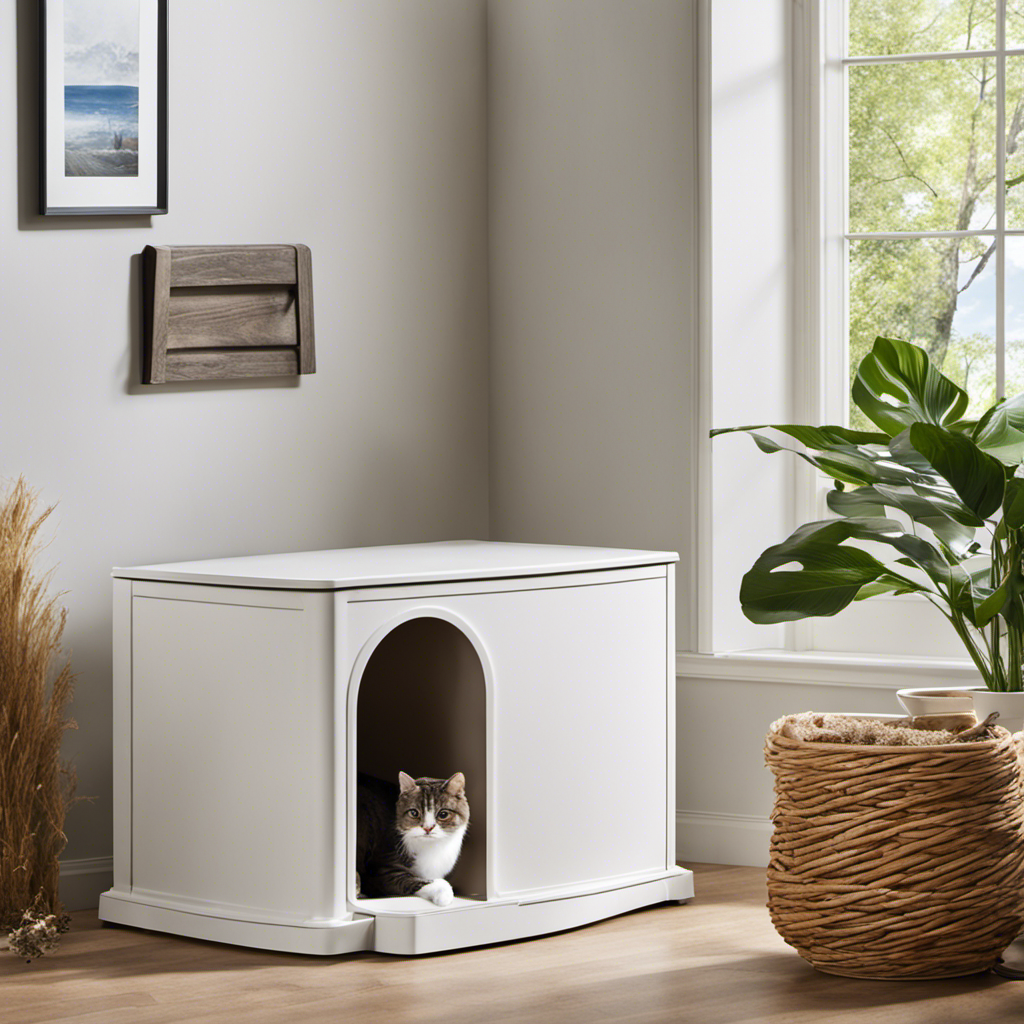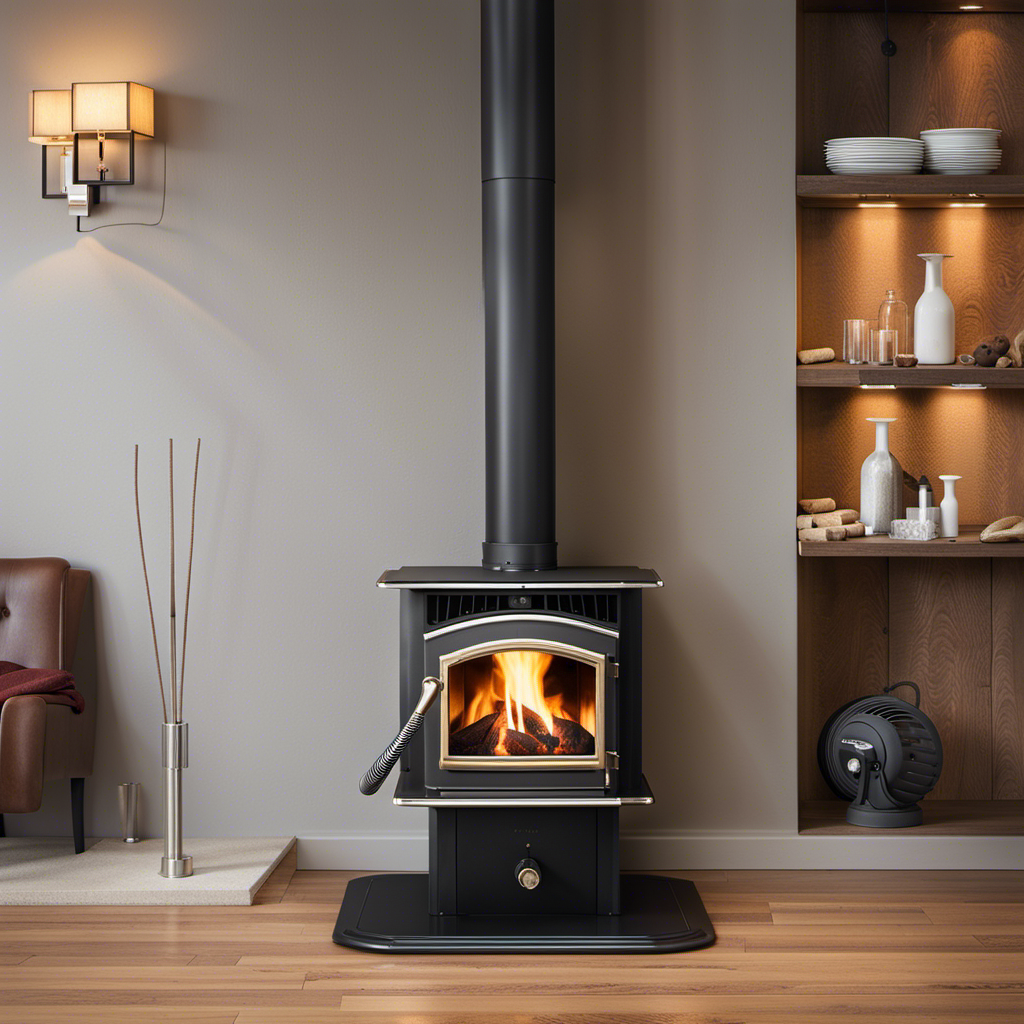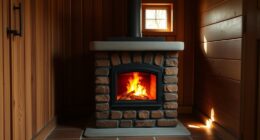I have always been intrigued by the workings of wood pellet fireplace inserts. It’s as if you have a mini power plant right in your own living space!
These incredible devices not only provide warmth and ambiance, but they also offer numerous benefits such as increased efficiency and reduced environmental impact.
In this article, we’ll delve into the intricate components of wood pellet fireplace inserts, explore their ignition and combustion process, discuss their heat output and safety features, and help you choose the perfect insert for your home.
Let’s dive in!
Key Takeaways
- Wood pellet fireplace inserts use advanced combustion technology for efficient burning.
- They minimize smoke and particulate matter released into the air.
- Wood pellet fireplace inserts utilize wood pellets as a sustainable energy source.
- They promote cleaner energy and healthier living environments.
Benefits of Wood Pellet Fireplace Inserts
One of the benefits of wood pellet fireplace inserts is that they are more energy-efficient than traditional fireplaces. This means that they can effectively heat your home while using less fuel, resulting in cost savings on your energy bills.
Wood pellet fireplace inserts are designed to burn wood pellets, which are made from compressed sawdust and other biomass materials. These pellets have a high energy density and produce minimal emissions, making them an environmentally-friendly choice.
The inserts are equipped with advanced combustion technology and efficient heat exchange systems to maximize energy efficiency. They also come with programmable thermostats and automatic ignition systems for convenient operation.
With their superior energy efficiency, wood pellet fireplace inserts provide not only warmth but also significant cost savings compared to traditional fireplaces.
Components of Wood Pellet Fireplace Inserts
To understand how they function, you’ll need to know about the different components of these fireplace inserts.
Wood pellet fireplace inserts are designed to maximize fuel efficiency and heating capacity. Here are the key components:
-
Hopper: This is where the wood pellets are stored. It holds a large quantity of pellets, allowing for longer burn times.
-
Auger System: The hopper is connected to an auger system that transports the pellets from the hopper to the combustion chamber.
-
Combustion Chamber: This is where the wood pellets are burned and heat is generated. The combustion process is carefully controlled for optimal fuel efficiency.
The fuel source for wood pellet fireplace inserts plays a crucial role in their operation.
Fuel Source for Wood Pellet Fireplace Inserts
You’ll need to consider the type of fuel source that best suits your needs for maximizing the efficiency and performance of your wood pellet fireplace insert. Wood pellets are a popular choice due to their high energy content and low moisture content. These pellets are typically made from compacted sawdust or other biomass materials, which are compressed into small cylindrical shapes. Pellets can be conveniently stored in bags or larger containers, making them easy to handle and replenish when needed.
When it comes to the combustion process, wood pellet fireplace inserts utilize advanced technology to ensure efficient burning. The pellets are fed into the combustion chamber through an auger system, where they interact with a controlled air supply. This regulated air flow allows for optimal combustion, resulting in minimal emissions and maximum heat output.
Transitioning into the subsequent section about the ignition and combustion process, it is important to understand how these factors play a crucial role in ensuring proper functioning of your wood pellet fireplace insert.
Ignition and Combustion Process
The ignition and combustion process in wood pellet fireplace inserts relies on a controlled air supply for efficient burning.
When it comes to the quality of pellets, there are a few factors that can impact their performance:
- Moisture content: Pellets with higher moisture content may not burn as efficiently and can lead to more emissions.
- Ash content: Higher ash content in pellets can result in increased maintenance requirements for the fireplace insert.
- Size and shape: Uniformity in size and shape ensures consistent combustion and heat output.
- Storage conditions: Proper storage is crucial to maintain pellet quality. Exposure to moisture or extreme temperatures can degrade the pellets.
Ensuring high-quality pellets and proper storage conditions will optimize the performance of your wood pellet fireplace insert, allowing for efficient burning and maximum heat output.
Heat Output and Efficiency of Wood Pellet Fireplace Inserts
When it comes to wood pellet fireplace inserts, there are two key points that I want to discuss: energy-saving benefits and heat distribution methods.
Firstly, these inserts are known for their energy-saving capabilities as they burn wood pellets efficiently, resulting in less waste and higher overall efficiency.
Secondly, the heat distribution methods used by these inserts ensure that the warmth is evenly distributed throughout the room, providing maximum comfort and eliminating cold spots.
Overall, understanding the energy-saving benefits and heat distribution methods of wood pellet fireplace inserts can help homeowners make informed decisions when it comes to heating their homes.
Energy-Saving Benefits
Wood pellet fireplace inserts can significantly reduce heating costs while also being environmentally-friendly. These inserts are designed to efficiently burn wood pellets, which are compressed sawdust or other biomass materials. The energy efficiency of wood pellet fireplace inserts is due to their advanced combustion technology and automated control systems.
One key benefit of these inserts is their high energy efficiency, which means that they convert a large percentage of the fuel’s energy into heat for your home. This results in significant cost savings on your heating bills compared to traditional fireplaces or inefficient heating systems.
To illustrate the potential cost savings, consider the following table:
| Heating System | Annual Heating Cost |
|---|---|
| Wood Pellet Fireplace Insert | $800 |
| Traditional Fireplace | $1,500 |
| Electric Heater | $2,000 |
| Oil Furnace | $2,500 |
| Natural Gas Furnace | $1,200 |
As you can see from the table above, using a wood pellet fireplace insert can save you hundreds or even thousands of dollars per year compared to other heating options.
With its exceptional energy efficiency and cost savings potential, transitioning to a wood pellet fireplace insert is an excellent choice for homeowners looking to reduce their energy consumption and expenses.
When it comes to heat distribution methods…
Heat Distribution Methods
If you’re considering heat distribution methods, one option to explore is using a blower or fan to help circulate the warm air throughout your home. This technique is widely used in wood pellet fireplace inserts to ensure efficient and effective heat transfer mechanisms.
The blower or fan, typically located at the back of the insert, pulls in cool air from the room and pushes it over the hot surfaces of the firebox. As the air passes over these surfaces, it absorbs the heat and becomes warm. By continuously circulating this warm air through strategically placed vents or ducts, it evenly distributes heat throughout your living space.
This method not only maximizes comfort but also reduces energy waste by eliminating cold spots and ensuring that every corner of your home receives adequate warmth.
Now let’s dive into another important aspect of maintaining wood pellet fireplace inserts: maintenance and cleaning.
Maintenance and Cleaning of Wood Pellet Fireplace Inserts
When it comes to maintaining and cleaning wood pellet fireplace inserts, there are several key points to consider.
First, understanding the appropriate cleaning frequency and methods is crucial in order to keep the insert functioning efficiently.
Regular maintenance is also of utmost importance as it ensures the longevity and optimal performance of the insert.
Lastly, troubleshooting common issues that may arise during operation can save time and money by preventing further damage.
Cleaning Frequency and Methods
Regular cleaning is important to maintain the efficiency and safety of wood pellet fireplace inserts. To ensure proper maintenance, it is crucial to clean them regularly using the right tools and following safety precautions. Here are some essential cleaning tools and safety measures that should be considered:
| Cleaning Tools | Safety Precautions |
|---|---|
| Soft brush | Use gloves when handling ashes |
| Ash vacuum | Turn off the unit before cleaning |
| Glass cleaner | Keep children and pets away during cleaning |
| Damp cloth | Wear a dust mask to avoid inhaling particles |
Importance of Regular Maintenance
To ensure the longevity and safety of your wood pellet fireplace, it’s vital that you prioritize regular maintenance. Regular maintenance is of utmost importance when it comes to keeping your wood pellet fireplace working efficiently and preventing any potential issues.
One key aspect of maintenance is cleaning. Cleaning frequency will depend on how often you use your fireplace, but generally, it’s recommended to clean it at least once a month during the heating season. This involves removing ash from the burn pot, cleaning the glass window, and checking and cleaning the exhaust vents. Additionally, it’s important to inspect and clean the hopper periodically to prevent any blockages or malfunctions.
By properly maintaining and cleaning your wood pellet fireplace regularly, you can ensure optimal performance and prolong its lifespan.
Now let’s delve into troubleshooting common issues that may arise with your wood pellet fireplace insert…
Troubleshooting Common Issues
If your wood pellet fireplace isn’t working properly, it’s important to troubleshoot common issues to identify and resolve the problem. Here are some maintenance tips to help you troubleshoot common issues with your wood pellet fireplace:
-
Check the power supply: Ensure that the fireplace is plugged in and receiving electricity.
-
Clean the hopper: A clogged hopper can prevent pellets from feeding properly into the fire. Regularly clean out any debris or dust in the hopper.
-
Inspect the auger: The auger is responsible for transferring pellets from the hopper to the burn pot. Make sure it’s not jammed or worn out.
-
Clean the burn pot and exhaust vent: A dirty burn pot or exhaust vent can cause poor combustion and inefficient burning. Regularly clean these areas to ensure proper functioning.
By following these troubleshooting steps, you can address common issues with your wood pellet fireplace and enjoy a warm and cozy atmosphere in your home.
Now let’s explore the safety features of wood pellet fireplace inserts without compromising on style or comfort.
Safety Features in Wood Pellet Fireplace Inserts
One of the safety features in wood pellet fireplace inserts is an automatic shut-off system. This system is designed to prevent fire hazards and the buildup of carbon monoxide. If there is a sudden increase in temperature or a malfunction within the insert, the shut-off system will automatically turn off the unit, ensuring that no further damage occurs. This feature provides peace of mind for homeowners, as it eliminates the risk of potential fires and dangerous gas leaks.
In addition to the automatic shut-off system, wood pellet fireplace inserts also come equipped with other safety features such as heat sensors and glass doors that remain cool to the touch. These features work together to create a safe and efficient heating experience for users.
When it comes to installation and placement of wood pellet fireplace inserts, careful consideration must be taken into account.
Installation and Placement of Wood Pellet Fireplace Inserts
When it comes to the installation and placement of wood pellet fireplace inserts, there are several key points to consider.
First, proper venting requirements must be met in order to ensure the safe and efficient operation of the insert. This includes ensuring that there is adequate ventilation for the exhaust gases and that any flue pipes or chimneys are properly sized and installed according to manufacturer guidelines.
Secondly, ideal positioning and location play a crucial role in maximizing the heat output and overall performance of the insert. It is important to choose a location that allows for easy access to fuel storage, as well as one that provides optimal heat distribution throughout the desired area.
Lastly, an overview of the installation process will provide valuable insights into what steps need to be taken in order to successfully install a wood pellet fireplace insert. This includes preparing the existing fireplace opening, connecting venting components, and properly sealing any gaps or joints to prevent air leakage.
Proper Venting Requirements
To ensure proper venting requirements for your wood pellet fireplace insert, it is important to follow the manufacturer’s guidelines and use an approved venting system. Proper venting is crucial for the safe and efficient operation of your fireplace insert.
Here are some important tips to keep in mind when it comes to venting installation and maintenance:
-
Choose the right type of venting system: There are different options available, such as direct vent or power vent systems. Consult with the manufacturer or a professional installer to determine which type is suitable for your specific fireplace insert.
-
Follow proper installation procedures: It is essential to install the venting system according to the manufacturer’s instructions. This includes ensuring proper clearances, sealing any connections properly, and using appropriate materials.
-
Regular maintenance: Keep your venting system clean and free from any obstructions that could hinder airflow. Inspect it regularly for signs of damage or wear, such as cracks or loose fittings.
By following these venting installation and maintenance tips, you can ensure optimal performance and safety for your wood pellet fireplace insert.
When positioning and locating your wood pellet fireplace insert…
Ideal Positioning and Location
For optimal performance and safety, it’s important to position and locate your wood pellet fireplace insert in a suitable area of your home. The ideal positioning for a wood pellet fireplace insert is against an exterior wall with access to venting options. This allows for efficient heat distribution throughout the room and easy installation of the required venting system.
When choosing the right location, consider factors such as proximity to combustible materials, clearance requirements, and ease of access for maintenance and refueling. Additionally, ensure that the chosen location meets the necessary venting requirements for proper airflow and exhaust extraction.
Once you have determined the ideal positioning and location, you can move on to the installation process overview without any further delay.
Installation Process Overview: Now that you have identified the ideal positioning and location for your wood pellet fireplace insert, let’s delve into the installation process itself.
Installation Process Overview
Now that you’ve determined the ideal positioning and location, let’s take a look at how the installation process works. Installing a wood pellet fireplace insert may seem daunting, but with the right steps and tools, it can be done smoothly.
Here are the installation steps to guide you through:
-
Prepare the existing fireplace: Clean out any debris and inspect for structural issues.
-
Measure and cut the flue liner: Ensure proper fit for ventilation.
-
Install the hearth pad: Provide a non-combustible base for the insert.
-
Place and secure the wood pellet fireplace insert: Align it properly and fasten securely.
To complete these installation steps, you will need some essential tools like measuring tape, masonry drill bits, wrenches, and screws.
With your wood pellet fireplace insert properly installed, let’s now shift our focus to understanding its environmental impact without further delay.
Environmental Impact of Wood Pellet Fireplace Inserts
If you’re concerned about the environmental impact, wood pellet fireplace inserts emit fewer emissions compared to traditional fireplaces. This is because wood pellets are a renewable source of energy and produce significantly less carbon footprint. When burned, they release fewer greenhouse gases into the atmosphere, helping to reduce air pollution and improve air quality both indoors and outdoors.
Wood pellet fireplace inserts use advanced combustion technology to ensure efficient burning of the pellets, resulting in minimal smoke and particulate matter being released into the air. These inserts also come with built-in emission control systems that further reduce harmful pollutants.
With their lower emissions and improved efficiency, wood pellet fireplace inserts are a sustainable heating option that promotes cleaner energy and healthier living environments.
When it comes to choosing the right wood pellet fireplace insert for your home…
Choosing the Right Wood Pellet Fireplace Insert for Your Home
When selecting the right wood pellet fireplace insert for your home, it’s important to consider factors such as size, heating capacity, and installation requirements.
Here are three key considerations to keep in mind when choosing the right wood pellet fireplace insert:
-
Size: Measure the dimensions of your existing fireplace opening to ensure a proper fit. The insert should seamlessly integrate into your space without any gaps or overlaps.
-
Heating Capacity: Determine the square footage that needs to be heated and select an insert with the appropriate heating capacity. This will ensure optimal warmth and comfort in your home.
-
Installation Requirements: Consider if you want a freestanding or built-in insert, as well as any venting or electrical requirements. Consulting with a professional installer can help determine what type of installation is best for your specific needs.
By carefully considering these factors, you can choose the right wood pellet fireplace insert that not only enhances the aesthetic appeal of your home but also provides efficient and eco-friendly heating.
The benefits of using a wood pellet fireplace insert include reduced carbon emissions, cost savings on heating bills, and convenient operation with easy-to-use controls.
Can Wood Pellet Fireplace Inserts be Used in Conjunction with Traditional Wood Burning Fireplace Inserts?
Yes, using pellet fuel fireplace inserts can be used in conjunction with traditional wood-burning fireplace inserts. The pellet fuel fireplace insert can provide additional heat and efficiency to the traditional fireplace setup, making it a versatile option for homeowners looking to enhance their heating options.
Can I Use Wood Pellet Fireplace Inserts in a Traditional Wood Burning Fireplace?
Yes, you can absolutely use wood pellet fireplace inserts in a traditional wood burning fireplace. This allows you to enjoy the ambiance of a real fire while using pellet fuel in the fireplace, which is a more convenient and efficient option for heating your home.
Frequently Asked Questions
How Much Do Wood Pellet Fireplace Inserts Cost?
When it comes to wood pellet fireplace inserts, the cost can vary depending on factors such as brand, size, and features. However, it is important to consider a cost comparison along with the benefits and drawbacks before making a purchase decision.
Can Wood Pellet Fireplace Inserts Be Used as the Primary Heat Source for a Home?
Yes, wood pellet fireplace inserts can be used as the primary heat source for a home. They are highly efficient and offer many benefits, such as reduced heating costs and lower environmental impact.
Are Wood Pellet Fireplace Inserts Noisy?
No, wood pellet fireplace inserts are not noisy. They provide a cozy and peaceful ambiance with the crackling sound of burning pellets. Maintenance is simple, and the benefits include energy efficiency and cost savings.
Can Wood Pellet Fireplace Inserts Be Used in Homes Without a Chimney?
Yes, wood pellet fireplace inserts can be used in homes without a chimney. They are an effective alternative heating option that requires regular maintenance to ensure proper operation and safety.
Do Wood Pellet Fireplace Inserts Require a Professional Installation?
Professional installation is recommended for wood pellet fireplace inserts. While it may increase the installation cost, it ensures proper setup and safety. I learned this after researching about wood pellet fireplace inserts and their requirements.
Conclusion
In conclusion, wood pellet fireplace inserts are a game-changer when it comes to heating your home efficiently and sustainably.
With their advanced combustion technology and automatic ignition systems, these inserts provide both warmth and convenience.
Not only do they offer impressive heat output and efficiency, but they also come with safety features that give homeowners peace of mind.
Installing a wood pellet fireplace insert is not only beneficial for your comfort but also for the environment, as they produce lower emissions compared to traditional fireplaces.
So why settle for anything less when you can have the best? Choose a wood pellet fireplace insert today and experience the cozy warmth like never before.
Logan’s affair with adventure began in childhood. He hailed from a small town where vast forests bordered one side and endless shores stretched on the other. His days were spent exploring uncharted woods, climbing tall trees, or listening to the tales of old sailors. This early immersion in a world brimming with stories and mysteries became the foundation of his passion for writing.


